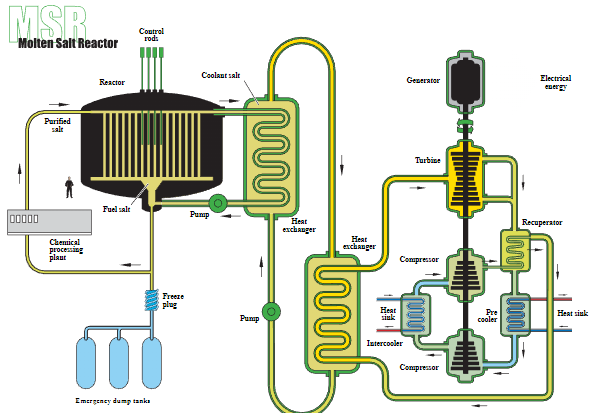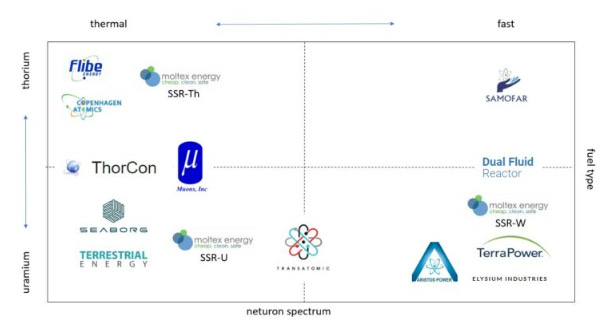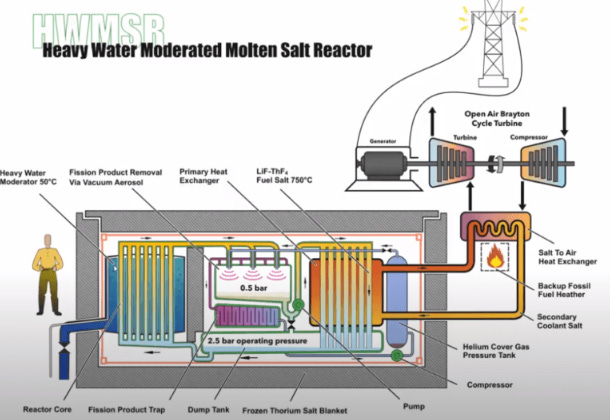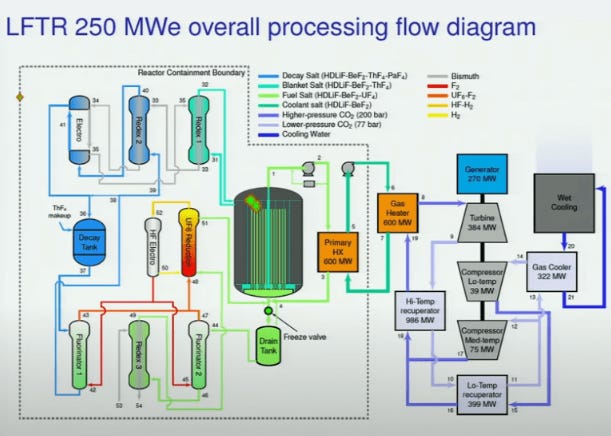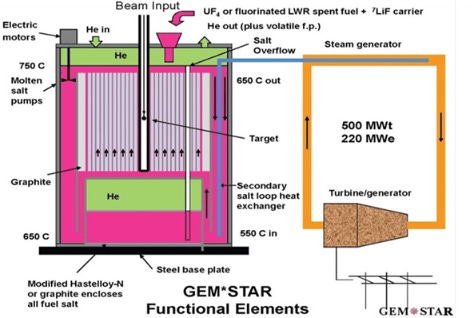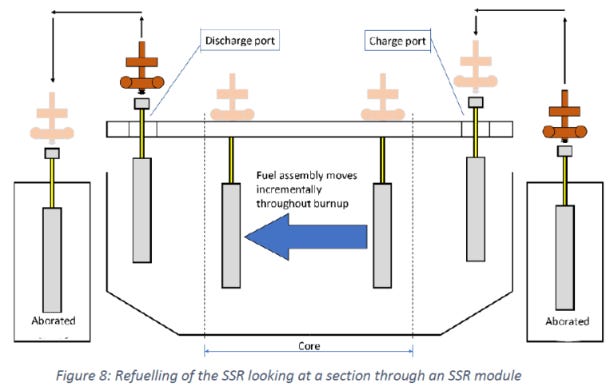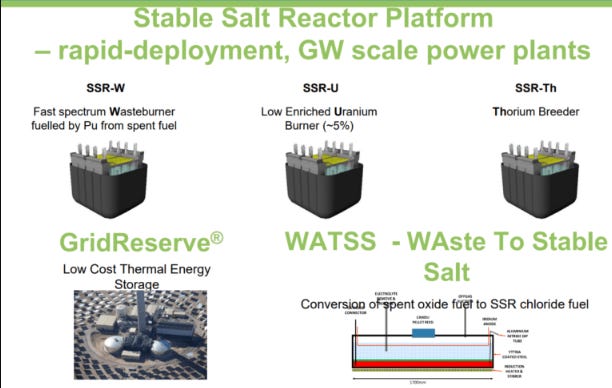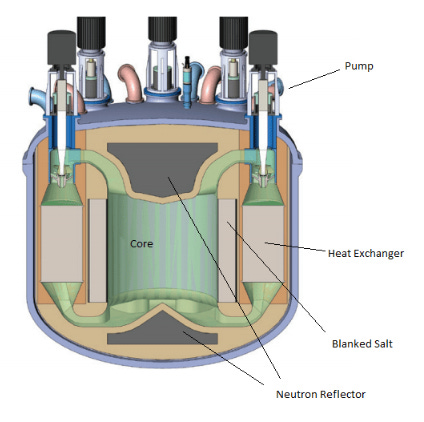Nuclear Energy: Salt-cooled Reactors
Salt-cooled reactors are one candidate design of the Generation IV International Forum.
There are two ways to use salt as coolant.
The first uses a clean salt to cool solid fuel elements. In the second type, the nuclear fuel is dissolved in the salt.
Different types of salt are under consideration for usage in nuclear reactors. Currently, fluoride salts are envisioned to be used mostly thermal reactors, as fuel solvent and also as coolant for solid fuel reactors. Chloride salts are investigated as solvent for fuel in fast spectrum reactors.
History
The research into the Molten Salt Reactor (MSR) started at Oak Ridge National Laboratory (ORNL) in the 50’s with the Aircraft Reactor Experiment (ARE). It ran for 100 hours at a power up to 2.5 MWth and reached outlet temperatures of up to 860°C, which might still be highest temperature ever achieved by a MSR. The ARE demonstrated that UF4 was chemically stable in the salt and that gaseous fission products like xenon bubbled out.
The liquids have in general a high thermal expansion coefficient. This means that the molten salt’s volume increases with temperature. Inversely, its density drops. The density of fissionable atoms in a given volume determines whether the material becomes critical.
For liquid fueled reactors, the characteristics of molten salts and the physical properties of the fuel create a so called negative temperature coefficient.
This means that if the reactor becomes too hot, the expansion of the salt reduces the power of the reactor. Inversely, if the reactor becomes too cold, the contraction of the salt increases the criticality and thus the power until the system is in equilibrium again.
Liquid fuels create an inherently stable operating point without the necessity for additional control systems. This was demonstrated in the ARE. In fact, the reactor could be ramped from zero to max without control rods by changing the power demand.
Afterward the experiments with the ARE, ORNL focused on graphite moderated reactors working with the thorium-uranium fuel cycle. A thorium blanket salt was used to produce U-233, which could easily be recovered by fluorination of the UF4 in the salt to the volatile UF6. It is the same process that is used to produce UF6 for uranium enrichment. ORNL conducted the Molten Salt Reactor Experiment (MSRE), which ran successfully for five years until end of 1969. The MSRE had a power output of 8 MWth and operated either with U-233, U-235 or Pu-239.
The experience gained was used to design the Molten Salt Breeder Reactor (MSBR), which had a large core to reduce neutron leakage and a low power density to reduce damage to the graphite moderator. This reactor was not built, though.
Technology
Molten salt offers several advantage: they have a rather high boiling point, which creates a high margin of safety for non-normal events. In most cases, several hundreds degrees, sometimes even over a thousand degrees of safety margin make a loss of coolant by boiling non-credible. The melting point is often in the range of 400-500°C. This places molten-salt reactors safely in the range of high-temperature reactor designs. But it also adds a disadvantage: if the temperature ever drops below this point, pumps, valves and pipes have to be able to cope with frozen, solid lumps of salt.
Because the salts remain liquid at high temperatures and ambient pressure, they can be the basis of a low pressure design for reactors. Like for metal-cooled reactors, this is supposed to offer significant cost reductions compared to a high pressure system, like water-cooled power reactors.
Most of the salts under investigation have a high retention capability for fission products. In the case of the solid fueled reactors, this adds another barrier against the release of fission products, for the dissolved fuel reactors, this is the primary retention mechanism of volatile fission products, like cesium or iodine. Nobel gases, notably xenon, bubble out of the salts, which offers an effective way of getting rid of this (thermal) neutron poison.
Liquid fuels add the advantage that their geometric shape is determined by their containers. This makes it possible to use dump tanks, which impose a shape on the salt that prevents it from becoming critical. This feature is included in the Generation IV International Forum’s (GIF) “reference design”.
The reactor is secured by a freeze plug. This is a flattened piece of pipe which is externally cooled, for example by a stream of helium at a well defined temperature.
This heat transfer keeps some of the fuel salt frozen in the pipe.
If external power is cut off, the cooling doesn’t work anymore, the salt clot thaws and the liquid core of the reactor drains safely into drainage tanks. Similarly, if the temperature of the reactor rises beyond some threshold, the cooling cannot keep the salt frozen.
This is a passive safety mechanism that fails safely, i.e. the only active part is the cooling of the plug. If it failed, the reactor would be transferred to a safe state.
I was referring to the GIF’s depiction as “reference design” in quotation marks, because the variety of reactor concepts that are pursued by commercial and research organizations is quite broad. Different fuel options and neutron spectra are investigated, as is visualized here:
In fact, it seems like there is no company that has faithfully adopted the GIF’s MSR illustration.
Despite the huge variety of designs, it seems all MSRs are facing some of the same issues. Almost all of them are related to materials. For example, the moderator used in the original MSR experiment at ORNL was graphite. But graphite has the undesirable property of first shrinking and then swelling beyond its original shape, if it is irradiated with neutrons. There are several strategies to handle this issue:
lower the power density and build a larger reactor vessel to keep the neutron fluence so low that the graphite survives long enough. This was ORNL’s approach.
keep the power density high, but replace the graphite regularly.
use another moderator
don’t use a moderator and opt for a fast neutron spectrum.
Approaches 2-4 are actively pursued by commercial companies. Other material issues relate to the structural materials, pumps, diagnostic systems etc.
There are several reasons for this. One is of course that the salts have to be selected for their thermal (specific heat) and hydraulic (viscosity) properties. Most of the candidate salts are fluoride or chloride based. A fission process splits fissionable elements into lighter elements, which changes the chemical and neutronic properties of the salt over time. It’s often said that a molten salt reactor that has been operating for a bit has half of the periodic table in it.
Recently, strong evidence was discovered that lithium fluoride salts are dissolving silicone carbide structures. This might eliminate one of the most promising candidates for a strong structural material to build especially dual-loop thorium reactors with. The compatibility of salts with structural materials like steel under intense neutron radiation is still being researched.
There is also an issue regarding the availability of certain chemicals. For example, the most promising salt in terms of neutronic, thermal and hydraulic properties is FLiBe. But this creates a tritium production problem, when natural lithium is used. Li-7 would be preferable, but there are no commercial lithium enrichment facilities for the scale that is needed. Additionally, enriching lithium-7 is simultaneously enriching lithium-6, which is of course a proliferation issue. Most fusion concepts that are currently under development will rely on lithium-6, which might create a synergy between fusion and fission approaches with regards to lithium enrichment.
Fast molten salt reactors are often using sodium chloride as solvent. To improve the neutronics of it, enriched Cl-37 is needed. This is not a proliferation relevant isotope. It should not be too hard technically to create a chlorine enrichment facility, but it does not seem like there are commercial offerings right now.
The fuel of these reactors is of course also subject to nuclear regulations. For this reason, Pu of any sort, HEU or HALEU is hardly obtainable.
Today, there is research interest in this technology from commercial and government research institutions. Russia seems to be somewhat active in the MOSART (MOlten Salt Actinide Recycler and Transmuter) project, China is investing heavily in a research program, where the utilization of thorium is investigated for once-through solid fueled reactors, cooled with salt, and liquid fueled reactors is investigated.
We will be looking at mostly commercial and one fairly open research project.
Kairos Power
Kairos Power is developing a solid fuel reactor, that is cooled with molten salt. This type of reactor, a fluoride salt-cooled high temperature reactor (FHR) has only recently been added as possible candidate for a Generation IV design.
Kairos Power’s approach is to use a well-studied, walk-away safe design, the pebble bed gas-cooled reactor and the TRISO fuel, that has been developed for that type of reactor, but shrinks the pebbles a little bit. This increases the surface-to-volume ration of the pebbles and increases the power density of the design. But the smaller pebbles also create smaller voids for coolant to flow through. This increases the pressure you have to apply to get your coolant through the reactor. In a gas-cooled design, this is not feasible, because any gains of a higher power density would be negated by a higher power consumption of the gas blowers. In the KP-FHR, the gas is replaced by molten salt. As a liquid, it has a far higher thermal capacity than a gas, so it can be moved far slower along the pebbles and still cool them efficiently.
The combination of a molten salt coolant and TRISO fuel should guarantee outstanding safety properties and a power density far superior to for example the sodium-cooled S-PRISM. TRISO fuel can withstand temperatures of up to 1800°C and the molten salt boils at ~1400°C. These are outstanding thermal margins.
If any fission products leaked out of the TRISO fuel, the salt is a very good solvent of them, which adds another barrier to the release of volatile fission products.
The KP-FHR will have a power output of 140MWe an a core outlet temperature of 650°C.
While this design is technically a salt-cooled reactor, it lacks the liquid fuel, which is the basis of most designs commonly referred to as MSRs. In a lot of ways, this design is idiosyncratic and leverages the work of different research communities efficiently.
errestrial Energy
Terrestrial Energy is a Canadian company developing a graphite-moderated, fluoride salt burner reactor, called the Integrated Molten Salt Reactor (IMSR). In contrast to the GIF reference design, this reactor has integrated heat exchangers.
Terrestrial Energy expects the graphite in the reactor to have a lifetime of 7 years. Because the safe exchange of the graphite in the field would be too demanding and expensive, the complete reactor core is exchanged.
A power station will therefore be equipped with at least two reactor units to ensure production during swaps.
errestrial Energy also does not have a freeze plug, but has to rely on passive air cooling for the core in a station blackout scenario.
This is the first reactor concept that is undergoing a new, joint review by the Canadian and US nuclear regulators.
In a series of interesting talks (here, here, here), the development process of the company and the reactor design can be traced.
Especially the reasoning behind pursuing a reactor with a thermal neutron spectrum, LEU fuel, no online reprocessing and without a breeding blanket were deliberately made to avoid regulatory issues.
Copenhagen Atomics
CopenhagenAtomics is a company hailing from Denmark. They are selling molten salt related equipment, like experimental salt loops and salt batches for rapid testing. Another molten salt specific test equipment under development is laser induced breakdown spectroscopy, which is used for measuring flowing molten salt, enabling real-time updates of the isotopic composition of the salt with ppm precision without “touching” the salt. Only less than one billionth of a gram of material is affected during a typical measurement. Laser pulses evaporate some of the salt and create micro-plasma, where the laser hits the salt. The composition of the salt determines what light is emitted by the plasma. A spectrometer analyzes this light to determine the composition of the salt.
But they are also developing a rather unique molten salt reactor, the HWMSR.
It is a thermal design, but uses heavy water as moderator. Heavy water is an excellent moderator and does not have any of the issues of graphite with regards to its shape. There are of course issues related to tritium production with this moderator.
A rather nice feature of this is the ability to drain the moderator, which is an effective way of regulating the reactor’s power output. Their design does not have freeze plug, rather the fuel salt is always draining through open pipes passively into a storage tank. Pumps have to be used to move it through the moderated zone and the heat exchanger. If power to the module gets shut off, the fuel and the moderator are automatically moved to save locations. Another rather interesting feature is the fission product removal stage. Instead of opting for a chemical reprocessing of the fuel salt, it gets sprayed into a low pressure atmosphere after leaving the moderated zone. The volatile fission products are moved with a washing gas to a fission product trap. After that, the cleansed, less volatile fuel salt is repressured and pumped through the heat exchanger.
The complete reactor is supposed to fit inside a standard container. This container is buried underground and heat-pipes are attached to it to act as passive heat removal path.
The moderated reactor zone is envisioned to be a silicone carbide structure, insulated with aerographite, which has phenomenal insulation properties. This material is supposed to withstand the huge temperature differences between the fuel salt and the cool moderator. It does not appear that this material has been qualified for nuclear usage, yet.
Seaborg Technologies
Seaborg is another company from Denmark! They are developing the Compact Molten Salt Reactor (CMSR). It is supposed to fit in a 20′ container and deliver up to 250MWth. This design does not use graphite as moderator, but a liquid, at least at the operating temperatures: NaOH.
The design features a freeze plug and is supposed to be able to operate on conventional nuclear fuel, as well as a combination of spent nuclear fuel (SNF) and thorium
The compactness of the core is claimed to be the result of the usage of a liquid moderator. The core outlet temperature is normally 700°C, but can go as high as 900°C for special applications like hydrogen production.
Seaborg Technologies is also developing multi-physics code that is MSR relevant and is supposed to help for licensing applications.
ThorCon Energy
ThorCon is developing not only a reactor, but a complete power plant. Leveraging the experience of their founders in super tanker ship construction, they have build their power plant to be manufactured in a shipyard. This means that plate steel construction techniques are used for most of the plant.
The plant is built in modules of between 150 and 500t, assembled in the shipyard. The whole plant is buoyant and towed from the factory to its destination. Once there, the double hulls are filled with sand or concrete. This acts as ballast to moor the plant to the seabed, but acts also as biological shield and protective layer against kinetic acts in other parts of the plant.
Their reactor is a graphite moderated burner. The lifetime of graphite in their reactor system is 4 years, so like Terrestrial Energy, they are opting for exchangeable reactors. ThorCon is not only exchanging the reactor core, but also the primary pump, off-gas handling system and primary heat exchangers in one big module, which they call a “can”.
There are 2 active cans supplying the heat for the steam generators and 2 cans in cool-down mode. There is a steel sleeve around each can. This sleeve is filled with water and called “cold wall”. Irradiated heat from the can warms the water and eventually turns some of it into steam. This is drives a natural circulation through a heat exchanger in a cooling pond. The cooling pond contains enough water for months of passive cooling after shut down. After that, indefinite air cooling should be sufficient. The basement is also flooded with water, which acts as a secondary, passive source of cooling for up to 350 days.
ThorCon uses 3 salt loops: the primary containing the fissile material, a similar salt for getting the heat out of the can and a tertiary salt loop, which uses “solar salt”, a type of salt commonly used for concentrated solar thermal power plant. This tertiary salt has a high tolerance for moisture, which the other salt does not.
The tertiary salt is used to drive a common, supercritical steam turbine.
Each “can” produces 557MWth, for a combined power output of over 500MWe.
The reactors are run with a mixture of thorium and HALEU, which, is supposed to reduce the amount of plutonium, but it could also be run on even sub-standard LEU.
ThorCon presents some astounding estimates regarding their system: a shipyard estimated the costs of the system at only 800-1000$/kW, which leads to LCOE of only 0.03$/kWh. They also estimate that a single large shipyard could produce 20 GW worth of reactors per year.
ThorCon is currently working out an agreement for a prototype with the government of Indonesia, a country with huge and growing demands for cheap electricity.
A presentation of the design can be found here.
Flibe Energy
Flibe Energy is a company focused on building a thermal thorium breeder reactor, called Liquid Fluoride Thorium Reactor (LFTR). This reactor is a dual-fluid reactor, which has a fuel and a blanket salt that get circulated through the core.
The U/Th cycle hardly produces enough neutrons to enable a breeding reactor. In the thermal spectrum, only 2.3 neutrons get released for every U-233 fission. It is enough in theory to enable a sustained thermal thorium cycle, but it is hard to realize. That is the reason, why a rather delicate online reprocessing plant has to be attached to each LFTR.
If Th-232 absorbs a neutron, it becomes Pa-233, which decays to U-233 with a half-life of roughly a month. Pa-233 has to be removed as fast as possible from the blanket and let to decay in a specialized tank. U-233 is extracted from it by adding fluorine to it. Uranium turns into a gaseous chemical, Pa and Th do not.
f everything worked as planned, in equilibrium only ThF4 had to be added and actinide-free fission products would leave the system as waste stream.
There are some proliferation concerns, because rather pure fissile U-233 gets generated.
The chemical processing of high temperature, high radioactivity fuels does still pose research and development challenges. Hastelloy N has been used in the original MSRE, but it does not appear to have been nuclear code qualified yet.
The commercial availability of 250MWe supercritical CO2 turbines seems also not sure yet.
Muons, Inc
Muons , Inc is developing the GEM*STAR reactor system. It is a thermal spectrum, graphite-moderated, fluoride-salt cooled reactor in a sub-critical configuration. A proton beam is injected on a spallation target in the reactor, which releases enough neutrons to make the reactor critical.
A primary application for this system is the disposition of excess military plutonium. The independence of the neutrons from fission reactions enables a much higher burn-up of the fuel. The accelerator is also seen as an additional active safety feature.
A reactor like this could run on U/Th as fuel.
Transatomic Power
TransatomicPower was a startup trying to develop an epithermal reactor. It is not moderated by graphite, but by zirconium hydride, it does not use FLiBe but, LiF, which is supposed to dissolve up to 27 times as much uranium. The reactor is supposed to run on standard LEU and the current design is a 1250MWth reactor. Initially, this reactor was thought to be capable of running on unprocessed SNF. It later turned out that this was due to an error in the neutronics calculations.
The company ceased operations shortly after that mistake was discovered and open-sourced all documents.
Moltex Energy
Moltex is a company originally working out of the UK. More recently they are active in Canada as well and are actively participating in some SMR initiatives. They are developing a family of reactors, called Stable Salt Reactors (SSR). Their reactor core designs have a unique property: their fuel salt is not pumped around.
In all other molten salt designs, highly radioactive fuel salt has to be moved through the core, Moltex is instead opting for putting the fuel salt in fairly standard fuel assemblies.
This approach could also ease some regulatory burdens, as proliferation controls could be done in the normal manner: counting fuel assemblies.
The fuel tubes are manufactured from standard steels, but they are coated with some sacrificial metal to ensure the fuel assemblies survive for up to 7 years in the reactor system. The liquid fuel salt still thermally expands in the tubes, offering a highly negative reactivity coefficient.
Moltex envisions a modular reactor construction. They build standard modules that contain heat exchangers, pumps, shutdown blades, etc. and can build a reactor core by assembling multiple, identical modules for the desired system power.
The fuel assemblies in the reactor tank are surround by a clean, fission product and fissile free coolant salt, which does not react violently with air or water.
The coolant salt exchanges its heat with a tertiary, solar salt. This salt can be stored in large, thermally insulated tanks. This storage system, called GridReserve, is used to transform the output of this reactor system into a peaking power plant.
The plant can easily be refueled. New assemblies are introduced at the outer periphery of the tank and incrementally moved in steps through the core.
oltex is developing a fuel recycling process called WATSS, which will transform spent CANDU fuel into the chloride based fuel for the SSR-W, which is a fast spectrum actinide burner.
The fission product waste stream will only have to be stored for approximately 300 years.
Moltex is also developing the SSR-U, which is a thermal reactor running on LEU. In this reactor, the fuel assemblies holding the fuel salt, which is fluoride based in this case, is surrounded by a graphite block. The graphite is part of the fuel assembly and gets removed from the core with it.
A third type of reactor is the SSR-Th. It’s based on the SSR-U, but instead of a clean coolant salt, the coolant will now contain thorium. The coolant is continuously circulated through a bismuth extraction column, which will remove Pa-233 and U-233 from the system. The bred U-233 is diluted with U-238 to LEU, which can be used in a SSR-U. The waste of a SSR-U can be used in SSR-W reactors.
The current focus of Moltex is on the SSR-W reactor. According to the founder Ian Scott, the chemistry of the salts inside the tubes is easier to control and the revenue stream is potentially large, given that Canada and especially the UK are in possession of large quantities of Pu, which are a liability to them.
Moltex got assessed independently by a UK nuclear engineering company. For a NOAK 1GWe reactor, a capex of £1330/KWe and a LCOE of £33.15 was estimates, for a plant with a 3.2 GWe maximum output, a 1GWe reactor and a 6GWh thermal storage, a capex of £601/kWe and LCOE of £38.21 was assessed.
These are really, really good figures. Especially for the peaking plant looks quite profitable in that regard.
SAMOFAR
SAMOFAR is a European research project on a fast spectrum thorium breeding reactor, the Molten Salt Fast Reactor (MSFR). It is envisioned to use a fluoride based salt (LiF). The vessel is cylindrical and has a diameter and height of 2.25 m. It is made from a nickel-based alloy to withstand the operating temperature of 750 oC. The fuel salt, 18 m3 in total in the primary circuit, is pumped from below through the central core zone and in downward direction through the heat exchangers, which are located circumferentially around the core. A container for the blanket salt is in the core.
The reactor is supposed to be operable at the full range from breeder to burner. The cause for this flexibility is the fact that the fuel salt composition can be changed continuously during reactor operation. A fraction of the salt, in the range of ~50l/day is diverted into an ex-core salt clean up unit, which extracts lanthanides and actinides.
The research project focuses on a 3 GWth reactor. This illustration is indicative of the high power density that can be achieved with a fast spectrum molten salt reactor.
The reactor features a freeze plug and passively cools the drained fuel salts in the tanks with a surrounding layer of salt, which acts as heat sink. Melting salt needs a lot of heat and once molten, the salt can transport and disperse the heat via highly effective convection in the liquid.
Terrapower
TerraPower is mostly known for their work on the sodium-cooled traveling wave reactor. But they are also working on a fast reactor, which is fueled with a chloride salt. It’s called the Molten Chloride Salt Fast reactor.
TerraPower is cooperating with Southern Company, to develop this reactor. The U.S. Department of Energy has already invested more than $28 million in cost-shared funds for the identification and test of materials used in the reactor.
The MCFR will be optimized to operate as commercial reactor that can produce up to 1.2 GWe. The heat generated by fission in the fuel salt is transferred to a secondary salt, which can be used for thermal storage or chemical processing. It is hailed for its simplicity, fuel cycle and proliferation characteristics. The reactor is walk-away safe, which means that it can be transferred to a safe state without electricity. The MCFR can work on multiple fuels, including depleted, natural uranium and SNF. It can load follow.
Southern Company and TerraPower are in the final stages of the design phase for an integrated effects test facility in support of the MCFR program, in cooperation with ORNL, INL, Vanderbilt University and Electric Power Research Institute.
Elysium Industries
Elysium Industries is a US based company, which is developing the Molten Chloride Salt Fast Reactor (MCSFR), which as several highly interesting features.
Let’s start with the design philosophy around “scalability”. While most nuclear startups want to build small reactors and deploy many of them to get the desired power level, Elysium chooses another way. Their reactor core is “a can”, without internal structures.
Inside this can is the molten fuel salt. A reactor becomes critical, if enough fissile material is contained in geometric arrangement, which allows to sustain a chain reactions. If the composition of the fuel is fixed, this means that you always need exactly the same amount of fissile material to become critical, if the shape of your reactor remains the same. Given the strong negative temperature coefficient of a molten chloride salt, this means that your reactor power is a function of how much heat you can extract from the core, not strictly of the core size.
This allows Elysium to deploy different system sizes with exactly the same reactor core, which is 9 m tall and 3.7 m in diameter.
This enables a utility to start smallish and increase the power output of the system by adding more heat exchangers. No new reactor core would have to be purchased. Another interesting feature of this approach is with regards to the licensability of the system. A reactor with a small thermal power output is supposed to be far easier to license than a large reactor system. Subsequent power upgrades can rely on safety analyses done for the smaller systems and should also be a simpler task than licensing a large reactor from the start. The reactor could also double duty as fast test or isotope production reactor: just place your test assembly into the fuel salt and adjust the fuel salt level for the equivalent of the test assembly’s reactivity.
Another really special feature of the MCSFR is that its core is constantly draining. Two pipes with well defined diameters are constantly emptying the core into a sub-critical drain tank. Fill-up pumps actively move fuel salt from the drain tank to the reactor core. If these pumps trip, are switched off or there is a complete loss of power, the core immediately drains.
The heat gets transferred to modular, non-cylindrical salt-salt heat exchangers, which ensure high neutron leakage and separation from the core to eliminate criticality concerns. This heat exchangers are also connected to the dump tank so they can passively drain the salt into a safe configuration.
The core is not insulated. Instead the core, the drain tank and the heat exchangers are all surrounded by molten secondary salt; the same salt as in the primary heat exchangers. This adds huge thermal inertia to the complete system.
Interestingly, the superheaters are cooler than this buffer salt during operation, so the heat of the reactor that is “lost” from the core can still be used to heat the steam in the superheater. The chloride fuel salt does not boil until ~1400°C, resulting in low pressures. The reactor containment temperature is approximately 650°C. This allows the use of existing qualified structural materials. Later evolutions of the this reactor will use non-nickel materials to raise the output temperature to 950°C.
In case of a loss of heat sink, the core is emptied into the drain tank. Decay heat will warm the buffer salt. If the temperature rises high enough, the heat pipes become activated. This threshold temperature can be precisely set for a heat pipe by choosing an appropriate combination of pressure and working fluid inside the tubes. They will become a thermal superconductor and move heat out of the buffer salt, ultimately to ambient air. Below the threshold, they are thermal insulators. The heat pipes are segmented, which keeps enough containment layers between the fuel salt and the environment for regulatory purposes.
Elysium is also developing a fuel cycle to convert SNF and excess military Pu into starting fuel.
The reactor can tolerate a wide range of fuels: The fuel-salt is NaCl-XClz-UCl3/4-PuCl3-FPCly with 10-20% fissile actinide fraction. Options for fissile are Pu, military or civilian and HEU, which both would have to be denatured with SNF, or HALEU. After the startup, only fertile material has to be added, which can be LWR/CANDU SNF, depleted uranium, natural urainum, or thorium in combination with >88% U-238, to keep it below IAEA thresholds at any time.
Gaseous fission products and noble metals are the only fission products that get removed during operation. With this strategy, there is no need for an online reprocessing of soluble fission products. The reactor could run for 40-100 years, but the reactor vessel will probably have to be removed after 40 years, which is as good a time as any to ship the fuel to a reprocessing site, where 90% of the fission products are removed. The uranium, plutonium, minor actinides and remaining fission products could be shipped to a new reactor, after it is diluted with UCl3. The removed fission products have a rather low half-life and are headed for disposal. The fuel consumption rate is ~1 ton U / GWa electric.
The goal of Elysium is to provide cheap power. To achieve this, the non-nuclear part of the power plant is also optimized. In a 2019 presentation, the power conversion section was shown. In this setup, there is not a regular steam generator, but a low-cost Loeffler boiler.
The superheated steam returning from the superheaters in the containment is split into two streams: 1/3 is sent to the turbines, while 2/3 are sent to the Loeffler boiler. The superheated steam is sprayed through mixing nozzles with feed water to create pressurized, saturated steam, which is then sent to the superheaters.
This construction also helps to minimize the mass of water that is inside the containment and thus near to the salts at any time.
Dual Fluid Reactor
The “Dual Fluid” reactor, developed in Germany. It features a liquid fuel salt, which is cooled by liquid lead. This enables a uniquely high power density.
The reactor is envisioned to use refractory metals, like tungsten or niobium, or cermics like SiC for the core (yellow). The operating temperature is envisioned to be 1000°C. It is supposed to be running on an “undiluted” salt, which is 80% UCl3 / 20% PuCl3. For an enhanced neutron economy, Cl-37 is supposed to be used. The breeding ratio is 1.25 for a 3 GWth reactor with a blanket. In an alternate design, the fuel is molten metal as well! An alloy of 71% U / 9% Pu is used as fuel. The rest is probably used to form an eutectic to bring the melting point down. This is supposed to achieve a breeding ratio of 1.6. Both versions could also be run with a U-Th fuel, albeit with worse breeding ratios and the need for a breeding blanket. The liquid fuel would have to be cleaned by a processing unit to remove fission products online.
Aristos Power
Aristos Power is hailing from Kazakhstan and developing the Hard Spectrum Reactor. It is a lead-cooled iso-breeder with a chloride salt fuel. The salt remains in a tank and is not pumped around. The core is traversed by the molten lead from a primary lead pool.
This primary lead is cooled in heat exchangers by lead from a secondary lead pool. This lead leaves the reactor to be used in a thermodynamic cycle and is returned to the secondary pool. The reactor is envisioned to be running at 750°C. This high temperature makes it necessary to manufacture the core using refractory metals. An enrichment of Cl-37 is not necessary.
The reactor is rated at up to 300 MWth. In a talk by the CEO of Aristos Power, Andrei Andrei, an eight-pack configuration of this reactor was shown, which would be an impressive 2400 MWth in a rather small footprint. The designers aim at building the plant without cooling towers to increase public acceptence.
Summary
There is a lot of activity in the sector of molten salt reactors. The differences in their designs are huge; they span different fuel salts, different neutron spectra, materials and safety systems. Some of these designs are quite mature and even on their way through the regulatory process. These are using “standard” uranium fuel, a well known moderator and replace the reactor system to cope with graphite swelling.
If these systems were able to deliver on their projected LCOE and CAPEX, they could represent an alternative to coal power plants in developing countries.
This would be a major contributor to combat climate change, which will have to focus on reducing future emissions of fossil power by offering clean systems that are cheaper than coal as soon as possible. Developing nations have a huge demand for electricity. Once an investment in a coal power plant is made, it will probably run for its technical life. Not building them is the best shot we have at reducing emissions.
Fast reactors could potentially be even cheaper than thermal reactors, but will probably face harsher regulatory challenges. They do not rely on degrading moderators, which should enable a longer system life and lower recurring cost. Fast reactors can even eliminate the need for enrichment facilities in the long run, but would of course have higher amounts of Pu in the the core, which is a political concern.


